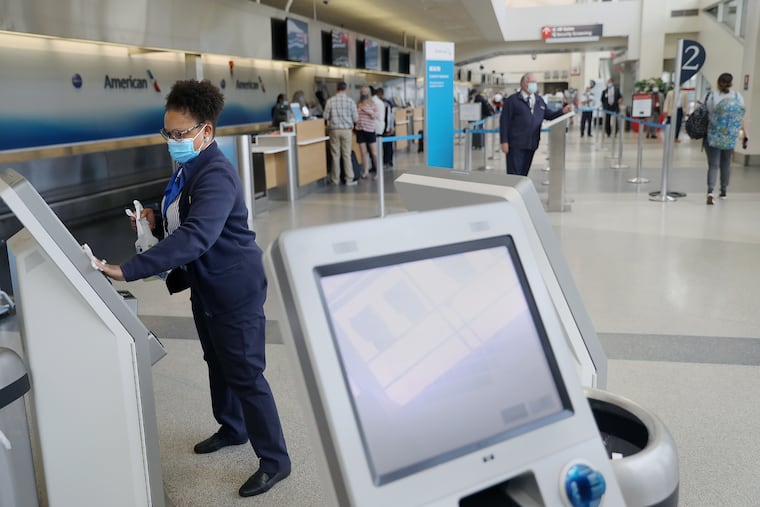A decade of Philly tourism growth crashes in the pandemic, new city numbers show
While incoming international flights from Europe are to land again in Philadelphia, the region has a ways to go to recover from the impact of the coronavirus on tourism.

The trend line was up and up: 46 million visitors came to the Philadelphia region in 2019, the 10th year in a row of tourism growth, according to data released by the city and tourism officials on Thursday.
Those visitors — mostly coming from around the United States — spent $7.6 billion across the five-county region.
Then came the pandemic, “and its sudden and devastating impact on the industry in terms of visitation, hotel occupancy, spending, revenue, taxes and jobs,” Mayor Jim Kenney’s office said in a statement accompanying the report.
Out of 188,000 people working in travel and tourism, 37% — or 70,300 employees — were out of work through June. From March through July, the region registered losses of an estimated $4.1 billion in economic impact.
“Hospitality has been one of the region’s largest and fastest growing employment sectors,” Kenney said in the statement. “Our COVID-19 economic recovery is underway, and our administration is working with industry leaders to bring back visitors and jobs and to restore the $342 million in tax dollars that the industry generates for the city’s budget each year.”
Philadelphia International Airport also announced on Thursday that it can start receiving passenger flights from Europe again, effective Monday. Since mid-March, federal travel restrictions have directed passenger traffic from the United Kingdom, Ireland, and much of continental Europe to so-called funneling airports for health screening — and PHL, for reasons left without public explanation, never received funneling status from regulators.
Starting Monday, passengers arriving in the U.S. from certain countries — China, Brazil and the 26 nations that make up the Schengen Area in mainland Europe — will no longer have to land at funneling airports, the Centers for Disease Control and Prevention said Wednesday.
The change does not fix all of the financial difficulties that the airport faces. “However, being able to accept international flights will help us recover faster and may save jobs that were on the verge of elimination,” PHL CEO Chellie Cameron said in a statement.
In 2019, 707,000 visitors traveled to Philly from overseas (not including Canada or Mexico) — up 1.5% from 2018, according to the Philadelphia Convention and Visitors Bureau. The organization promotes the city internationally, and markets it for business conferences.
Those international tourists spent $606 million directly in 2019, a spokesperson said, citing calculations by Tourism Economics. That spending level was down 3.2% from the $626 million in direct spending by foreign visitors in 2018.
Physician David Nash, who is serving as chief health adviser to the visitors bureau, addressed questions from meeting planners in a videoconference Thursday.
He said he was “very confident” that a vaccine would be ready by early 2021, while continuing to stress the importance of wearing masks to curb the spread of COVID-19. Nash also said he was proud of upgrades to the ventilation systems at the Pennsylvania Convention Center, along with changes to cleaning protocols at many city hotels.
“When the city says it’s OK for us to have larger meetings, we’ll be there. ... We’ve got the cleaning down, we’ve got the ventilation down," said Nash, the founding dean emeritus of the Jefferson College of Population Health.
Still, when asked what else it would take for him to feel comfortable attending a conference, Nash urged additional precautions for larger events.
For a meeting of 50 people or fewer in an auditorium with social distancing, and in accordance with local health guidelines, “I’m OK with that tomorrow,” Nash said. But a gathering of 500 or 1,000 attendees would be a different story.
Under those circumstances, Nash said, he’d want to see a “testing plan” connected to the event, "where they would promote quarantine before coming,” ensure testing of all attendees, and provide access to medical care for those with questions or symptoms.
Nash likened that type of planning to the “bubble” that some colleges and sports organizations have put in place.
As for leisure travel, Jeff Guaracino, CEO of Visit Philadelphia, said he was encouraged by summer trends, including hotel stays in parts of Philadelphia County outside of Center City, and tourism in Bucks County.
Visit Philly soft-launched a marketing campaigned called “Our Turn to Tourist,” aimed at getting people in the region to travel closer to home. The campaign has gained traction in the New York City and Washington, D.C., markets, too, Guaracino said, and his organization will formally announce the campaign next week.
The group is also planning a round of research in late September to explore hesitation among travelers. Cold weather will pose its own tourism challenges, as it cuts into outdoor activities.
“We would normally be doing a year-long marketing plan," Guaracino said. "We’re currently focused in on the fall and the holidays.”